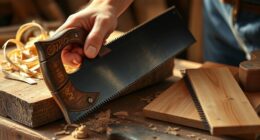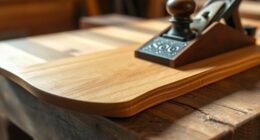To guarantee your miter saw stays accurate, regularly calibrate the angles using reliable gauges and fine-tune the adjustment knobs. Keep safety features like blade guards and lock-off switches in check to maintain focus and stability. Using properly aligned stop blocks allows for consistent cuts and prevents shifting workpieces. Maintaining your saw and secure stop blocks will improve precision and safety. Continue exploring how these steps work together for ideal results and precision.
Key Takeaways
- Regularly verify miter and bevel angles with a reliable square or digital gauge to ensure accuracy.
- Use adjustment knobs or screws to fine-tune saw angles and maintain precise cuts.
- Securely position and align stop blocks with a square for consistent, repeatable measurements.
- Maintain the saw and stop blocks regularly to prevent misalignments and ensure optimal performance.
- Safety features like blade guards and lock-off switches support accurate operation by reducing distractions and accidental movements.

Have you ever wondered how precise your miter saw really is? Achieving perfect cuts isn’t just about the saw itself but hinges on your ability to calibrate it properly and guarantee consistent results. Proper calibration directly impacts cutting precision, allowing you to make accurate angles and lengths every time. When your saw is correctly aligned, you minimize errors that could ruin your project or cause safety issues down the line. Safety features, such as blade guards and lock-off switches, are essential for preventing accidents, but they also play a role in maintaining precision. For example, a secure blade guard keeps the blade covered when not in use, reducing the risk of accidental contact that could throw off your focus or damage the saw.
To improve cutting precision, start by checking the miter and bevel angles regularly. Use a reliable square or a digital angle gauge to verify that the saw’s settings match the desired measurements. Minor misalignments can lead to significant inaccuracies over multiple cuts, so routine calibration is key. Most saws have adjustment knobs or screws that allow you to fine-tune these angles. Remember, a stable work surface and proper clamping are equally important—they prevent the workpiece from shifting during cuts, ensuring your measurements stay consistent. Additionally, regular maintenance can help keep your saw functioning at peak accuracy, preventing gradual misalignments over time.
Stop blocks are another crucial tool in maintaining accuracy. By setting up a stop block on your work surface, you can make repeated cuts of the same length without having to measure each piece individually. This not only saves time but also enhances safety because you control the workpiece more securely, reducing the chance of slipping or kickback. When attaching stop blocks, ensure they are firmly secured and aligned precisely with your desired cut length. Using a square to verify their position helps maintain consistency across multiple pieces.
Calibration and stop blocks work hand in hand to boost your miter saw’s performance. Regularly checking the saw’s alignment, utilizing stop blocks for repetitive cuts, and ensuring safety features are in place create a workflow that’s both accurate and safe. It’s tempting to rely solely on the saw’s built-in features, but routine maintenance and setup checks are what truly keep your cuts precise. When you prioritize calibration and proper setup, you’ll notice the difference in your craftsmanship—each cut will be cleaner, more accurate, and safer to execute. This approach guarantees your projects turn out exactly as planned, with minimal waste and maximum confidence in your tools.
Frequently Asked Questions
How Often Should I Calibrate My Miter Saw?
You should calibrate your miter saw every few months or whenever you notice inaccuracies in cuts. Regular saw blade maintenance helps keep cuts precise, and calibration ensures your angles stay true. Additionally, check dust collection efficiency, as buildup can affect performance. By staying on top of these tasks, you’ll maintain peak accuracy and safety, making each project smoother and more professional.
What Tools Are Needed to Calibrate a Miter Saw?
Think of calibrating your miter saw like tuning a musical instrument. You’ll need a combination square or a digital angle gauge to check blade alignment, ensuring it’s perfectly square. A tape measure or calipers help verify fence measurement, so cuts stay precise. Additionally, an Allen wrench set helps tighten any loose bolts. With these tools, you keep your saw in harmony, delivering accurate, clean cuts every time.
Can Improper Calibration Cause Safety Hazards?
Improper calibration can indeed cause safety risks when using your miter saw. If it’s not calibrated correctly, cuts may be inaccurate or slip, leading to potential injuries. That’s why calibration importance can’t be overstated—ensuring your saw is aligned properly reduces hazards and guarantees safer, cleaner cuts. Always double-check calibration before use, and use stop blocks for added safety and precision during your projects.
How Do Stop Blocks Affect Cut Accuracy?
Stop blocks markedly improve cut accuracy by providing consistent positioning for each cut. When you use them with precise stop block adjustments, you guarantee high stop block precision, leading to enhanced cut consistency. This minimizes errors caused by measuring or marking mistakes, saving time and reducing waste. Relying on well-calibrated stop blocks helps you achieve cleaner, more accurate cuts every time, especially on repetitive tasks where precision is critical.
Are Digital Miter Saws More Accurate Than Manual Ones?
Digital miter saws generally offer more accuracy than manual ones because they feature precision measurement tools and digital readouts for exact angles. You can set cuts more precisely, reducing errors. Manual saws depend on your skill and eye for measurement, which can vary. So, if you want consistent, accurate cuts with less guesswork, a digital miter saw is your best choice.
Conclusion
Now that you know how to calibrate your miter saw and use stop blocks effectively, you’ll enjoy precise cuts every time. Remember, a well-tuned saw is like a trusted partner, ready to bring your woodworking projects to life with accuracy. So, why settle for uneven cuts when a little maintenance can turn your saw into a cutting perfectionist? With these tips, you’re all set to craft with confidence and precision.








